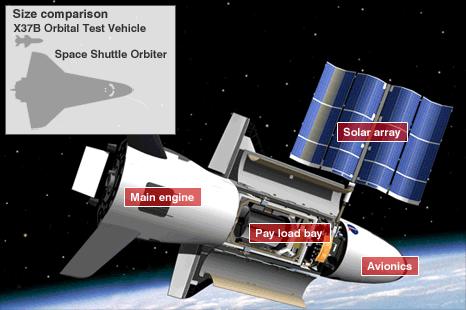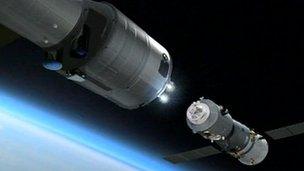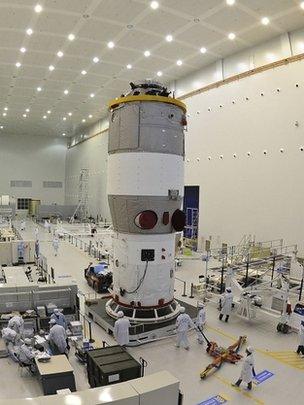X-37B spaceplane 'spying on China'
- Published
- comments
[UPDATE 8/1/12: This article has prompted quite a bit of discussion and I've added two links at the bottom where their authors explain why they think the premise does not stand up. JA.]
America's classified X-37B spaceplane is probably spying on China, according to a report in Spaceflight magazine.
The unpiloted vehicle was launched into orbit by the US Air Force in March last year and has yet to return to Earth.
The Pentagon has steadfastly refused to discuss its mission but amateur space trackers have noted how its path around the globe is nearly identical to China's spacelab, Tiangong-1.
There is wide speculation that the X-37B, external is eavesdropping on the laboratory.
"Space-to-space surveillance is a whole new ball game made possible by a finessed group of sensors and sensor suites, which we think the X-37B may be using to maintain a close watch on China's nascent space station," said Spaceflight, external editor Dr David Baker.
The X-37B, also known as the Orbital Test Vehicle (OTV), looks like a mini space shuttle and can glide back down through the atmosphere to land on a runway, just like Nasa's re-usable manned spaceplane used to do before its retirement last July.
Built by Boeing, the Air Force's robotic craft is about 9m long and has a payload bay volume similar to that of a small van. But what goes in the payload bay, the USAF will not discuss.
The current mission was launched on an Atlas rocket and put into a low orbit, a little over 300km up, with an inclination of 42.79 degrees with respect to the equator - an unusual profile for a US military mission which would normally go into an orbit that circles the poles.
The X-37B's flight has since been followed from the ground by a dedicated group of optical tracking specialists in the US and Europe, intrigued by what the vehicle may be doing.
These individuals have watched how closely its orbit matches that of Tiangong.
The spacelab, which China expects to man with astronauts in 2012, was launched in September with an inclination of 42.78 degrees, and to a very similar altitude as the OTV.

"The parallels with X-37B are clear," Dr Baker says in Spaceflight, the long established magazine of the British Interplanetary Society, external.
"With a period differential of about 19 seconds, the two vehicles will migrate toward or against each other, converging or diverging, roughly every 170 orbits."
No-one can say for sure what sort of mission the spaceplane is pursuing; all the USAF has said is that the OTV is being used as a testbed for new technologies.

An artist's impression of the recent Shenzhou capsule docking with Tiangong-1
But the suggestion any new sensors in the X-37B might take an interest in Tiangong's telemetry is certainly an interesting one.
Washington retains a deep distrust of Beijing's space ambitions - even its apparently straightforward human spaceflight missions.
Part of the problem is that China draws little distinction between its civilian and military programmes, unlike in other parts of the world, such as Europe, where the bloc's space agency, Esa, is committed by charter to "exclusively peaceful" programmes. European military space projects are the preserve of national governments.
In the US, also, that distinction is pretty clear with Nasa being charged with the majority of civilian projects.
In China, on the other hand, the lines are more blurred and the military reaches across all its space programmes.
"If this is what the X-37B is doing, I think it really is no bad thing," Dr Baker told BBC News. "As with the Cold War, the proliferation of space surveillance systems enabled us to get arms agreements that would not have been possible without each side knowing fully what the other side was doing."

Tiangong-1 was launched in September
Not everyone is convinced by the latest analysis.
Brian Weeden is a technical adviser to the Secure World Foundation, external and a former orbital analyst with the USAF.
He published his own assessment, external last year of the X-37B's capabilities and role as a platform to trial technologies before they are incorporated into a full-up spy satellite.
Mr Weeden still thinks the Middle East is a more likely target for any new sensors that the X-37B might be carrying.
"A typical spy satellite is in a polar orbit, which gives you access to the whole Earth," he told BBC News.
"The X-37B is in a much lower inclination which means it can only see a very narrow band of latitudes, and the only thing that's of real interest in that band is the Middle East and Afghanistan.
"Is it spying on Tiangong-1? I really don't think so. I think the fact that their orbits intersect every now and again - that's just a co-incidence. If the US really wanted to observe Tiangong, it has enough assets to do that without using X-37B."
The latest edition of Spaceflight, with its analysis on the X-37B, is published this weekend.
[UPDATE 8/1/12: Subsequent to this article's publication, Brian has gone into more detail on Space.com, external to explain why he thinks the X-37B cannot be spying on Tiangong-1.
And the noted NBC News Space Consultant, Jim Oberg, has posted his own assessment on the IEEE Spectrum's Tech Talk blog, external. Jim mailed me to say that although the spacecraft share similar inclinations, "they are in orbits which cross the equator about 90 degrees apart. They criss-cross each others' paths at thousands of meters per second. Any observation from one to the other is impossible."]

Tiangong-1 was launched in September on a Long March 2F rocket
The unmanned laboratory unit was first put in a 350km-high orbit
A Shenzhou 8 capsule rendezvoused and docked with Tiangong-1
The encounter tested key technologies such as life-support systems
Astronauts will visit Tiangong in 2012 in another Shenzhou vehicle
China aims to start building a 60-tonne space station by about 2020
- Published30 December 2011

- Published2 November 2011

- Published3 December 2010